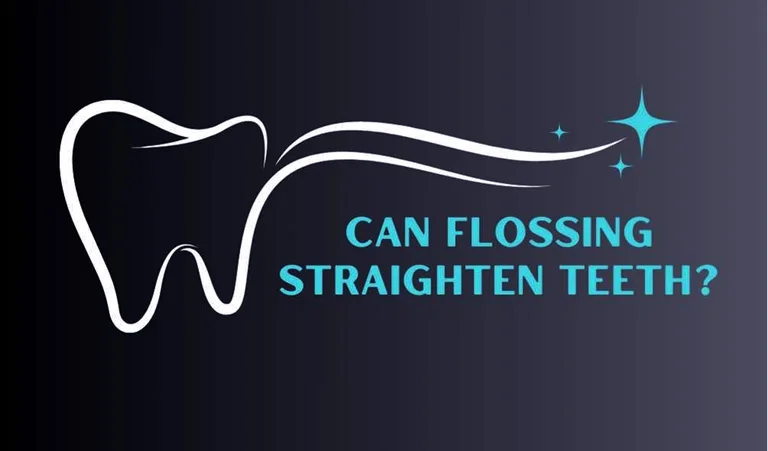Can flossing straighten teeth? In the quest for a confident smile, various dental practices and procedures come under scrutiny. One common misconception that circulates is whether flossing can play a role in straightening teeth.
Flossing promotes gum health and maintains cleanliness in these challenging-to-reach spaces. Orthodontic procedures, such as braces and clear aligners, are designed to shift teeth into proper alignment over time.
How Teeth Straightening Works
Chewing discomfort, recurrent headaches, excessive wear on the teeth and gums, gum disease, TMJ dysfunction, speech difficulty, and other issues have been linked to crooked teeth. The first step in teeth straightening is a comprehensive assessment by an orthodontist.
Orthodontic appliances work by applying controlled forces to the teeth. These forces encourage the teeth to move gradually over time. The orthodontist adjusts the appliances at regular intervals to ensure the teeth are shifting according to the treatment plan.
As the teeth move, the bone surrounding them undergoes a process called remodeling. Bone cells are broken down in areas of pressure and rebuilt in areas of tension. This allows the teeth to move into their new positions while maintaining stable support.
Regular follow-up appointments with the orthodontist are essential throughout the treatment process. These appointments allow for adjustments, monitoring progress, and addressing any concerns that may arise.
Can flossing straighten teeth?
While flossing itself doesn’t straighten teeth, it plays a pivotal role during orthodontic treatments. Orthodontic treatments are specifically designed to reposition teeth by applying controlled pressure to guide them into proper alignment.
There are several types of orthodontic appliances used to straighten teeth:
Braces: Traditional braces consist of metal brackets that are bonded to the teeth and connected by wires. The orthodontist adjusts the wires periodically to apply controlled pressure, gradually shifting the teeth into their desired positions.
Clear Aligners: Clear aligners are a series of custom-made, clear plastic trays that are worn over the teeth. Each set of aligners applies gentle pressure to guide the teeth into alignment. Aligners are removable and virtually invisible.
Lingual Braces: Lingual braces are similar to traditional braces, but the brackets and wires are placed on the back (lingual) surface of the teeth, making them less visible.
Braces consist of brackets bonded to teeth and connected by wires, while clear aligners are custom-made trays that gradually shift teeth into their desired positions.
Dispelling Misconceptions: Can flossing straighten teeth?
Contrary to the misconception, flossing cannot straighten teeth unlike orthodontic treatments. Flossing is not designed to apply the controlled forces necessary for repositioning teeth. Attempting to straighten teeth through flossing alone is both ineffective and potentially harmful to your oral health.
Crooked teeth are more than a cosmetic concern—they can lead to various oral health challenges and discomforts. Acting promptly to address crooked teeth is crucial. Seeking orthodontic treatment at the earliest signs of misalignment allows for more efficient and effective solutions.
Role of Flossing in Oral Hygiene
The often overlooked but equally important is the practice of flossing. It plays a crucial role in achieving optimal oral hygiene.
- Flossing removes plaque and food particles from between teeth, preventing the buildup of harmful bacteria that can cause gum inflammation and gum disease.
- By eliminating food debris and plaque from interdental spaces, flossing reduces the risk of cavities forming in these hard-to-reach areas.
- Flossing helps remove particles that can contribute to bad breath, ensuring a fresher and more pleasant oral environment.
Consistency is key for reaping the benefits of flossing. Make it a habit rather than an occasional practice.
Wrap up
Can flossing straighten teeth? Floss can remove dirt that your toothbrush missed, but it will not straighten your teeth.
Aim to floss at least once a day, preferably before bedtime, to remove debris accumulated throughout the day. By diligently flossing, you remove plaque, food particles, and bacteria from areas that brushing alone cannot reach.
FAQ
No. Flossing is used to clean plaque and food particles from between your teeth. Floss can remove dirt that your toothbrush missed, but it will not straighten your teeth.
Flossing and brushing can be less effective because they lack a straight edge against crooked teeth. You may experience discomfort, cavities, and filthy teeth if your toothbrush and floss cannot reach particular parts of your teeth.
You cannot straighten your teeth with dental floss. Rather you could go for orthodontic treatments. Orthodontic treatments like braces or clear aligners are designed to apply controlled forces to shift teeth into proper alignment over a period of time.
Brushing and flossing your teeth twice a day is one of the easiest and most efficient techniques to remove your braces faster. Food gets trapped in braces and bands more easily; utilizing an electric tooth brush and cleaning in a circular motion will reduce plaque buildup.
You should not try to straighten your teeth at home without braces. Straightening your own teeth with a borrowed retainer, rubber bands, paper clips, earring backs, homemade equipment, or other DIY cures suggested on the internet is highly unlikely to work and dangerous.

